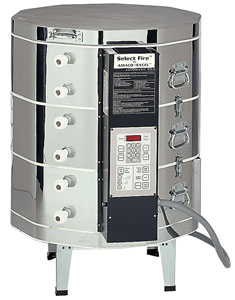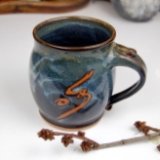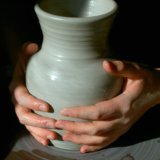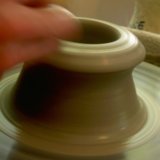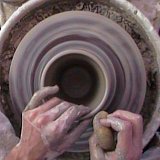|
Electric Ceramics KilnReview different kinds of kilns, find an electric ceramics kiln for sale, kiln firing book reviews, firing temperatures, use of cones, shelves, furniture, and more. One of the most recent developments in the history of kilns is the electric kiln. This kiln type uses electrical current sent through wire coils to heat the pottery.
This ceramic kiln is a top load style with the lid on top. Other types are front load, which have a swinging door on the front. Different potters prefer to use one or the other, but both are effective for firing pottery. The other features you can see are the six peep holes in the front with plugs. This is so you can view the inside of the kiln to see the color of the heat or check pyrometric cones (if you are using them). The kiln on the left has Select Fire Control, which is the little computer box on the front. This is used to control the rate of temperature rise in the kiln. It can even be programmed to hold the temperature during parts of the firing so you can do advanced glazing techniques that require special firing schedules. The simplest example of a glaze firing schedule is to heat the glazed pottery slowly for the first two hours, then quickly for the remainder of the firing, then finally to hold or "soak" the kiln at the end. Soaking means holding the heat at the same temperature for a period of time, usually an hour or two. At the end of a glaze firing this serves to even out the glaze and give any air bubbles time to escape before allowing the glaze to cool. You can also see that this Amaco kiln has three sections. This makes it easier to ship and transport, as the sections come apart. Each section has wire heating elements which rest in grooves in the kiln brick. The elements all connect to the control box. The elements can be removed from the kiln if damaged so you can repair them or get replacement parts. The other main equipment needed to use this kiln are kiln shelves and posts. Kiln shelves are made of special heat resistant material designed to withstand the high firing temperatures used for pottery. They are shaped to fit the specific kiln leaving just enough room on the sides for the heat and air to circulate around the pots. This size of kiln will almost always use 240 volt electrical, which is what your clothes dryer and kitchen stove usually use. Check the kiln manual before installing. Always have a certified electrician do your kiln wiring to ensure optimal function and for safety. OxydationAlthough additional minerals can be added to electric kilns to create a reduction effect, it is more common to simply heat the ware to the desired cone. The reason minerals are rarely added is because the kiln elements become damaged quickly when fuels and minerals are introduced, which would require more maintenance and replacement parts. Electric kilns are more commonly fired in an "oxidation" atmosphere. Firing pottery in oxidation basically means that no additional fuel or minerals are added to the kiln during firing. The oxygen in the kiln has not been manipulated to affect the glazes in any way. Note: Most bisque firings are done in electric kilns. The oxidation atmosphere is a very predictable, but often results in somewhat flat glaze surfaces. Electric kiln firing receives some criticism for this drawback. However, many recent developments in glazes have opened up opportunities for a wider range of possibilities for electric pottery kiln firing.
If I could recommend only one book about working with an electric kiln it would be Electric Kiln Ceramics: A Guide to Clays and Glazes It is one of those beautiful, valuable resources the pages of which have become speckled with glaze, creased, marked, and muddied from loving use. It's loaded with forming techniques as well as clay, glaze and firing information. All of it is written in a way that suits any level of potter. You don't have to be a chemist or an engineer to understand it. It isn't cheap, but the information in the book is well presented and worth every penny. I haven't found a better book at a better price. If anyone knows of one, please let me know so I can post it here.
Related PagesBisque Ceramics
Return From Electric Ceramics Kiln |
Learn Right
The First Time
Pottery on the Wheel for Beginners
is a complete beginners guide
to learning pottery.
It will
take you from
never having touched clay
to creating finished pottery
you can use every day.
Also read it on Kindle
Featured Pages
Choose Your Wheel
Thank you so much for
visiting my website!
Discover How I Made It!
Happy Potting!
- Steve





